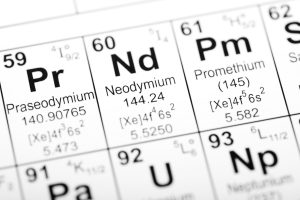 As the world pursues ambitious net-zero carbon emission goals, demand is soaring for the critical materials required for the technologies leading the energy transition. Lithium may be the most well-known of these inputs due to its usage in batteries for vehicles and consumer electronics, but roughly 50 other minerals are central to energy transition technologies. During the coming years, producers, manufacturers and end-users will be increasingly exposed to the roles played by “rare earth” elements (roughly, atomic numbers 57 to 71), platinum group metals, and other materials.
As the world pursues ambitious net-zero carbon emission goals, demand is soaring for the critical materials required for the technologies leading the energy transition. Lithium may be the most well-known of these inputs due to its usage in batteries for vehicles and consumer electronics, but roughly 50 other minerals are central to energy transition technologies. During the coming years, producers, manufacturers and end-users will be increasingly exposed to the roles played by “rare earth” elements (roughly, atomic numbers 57 to 71), platinum group metals, and other materials.
The reasons for this heightened interest are simple—even if the underlying environmental, political and technological forces at play are complex:
- Lower-carbon technologies use different materials than carbon-intensive technologies.
The mineral requirements of power and mobility systems driven by renewable, nuclear, hydrogen and fusion energy are profoundly different from those forming the backbone of fossil fuel systems. Minerals such as lithium, nickel, copper, cobalt, and rare earth elements are vital for electric vehicles (EVs), batteries, fuel cells, electricity grids, wind turbines, smart devices, and many other essential and proliferating civilian and military technologies. For example, an offshore wind plant needs 13 times more mineral resources than a gas power plant of a similar size.
- Ambitions for global electrification require extraordinary material production increases.
If the North American vehicle fleet goes all electric, we will need 34 times the 2020 production of key rare earths. A large share of world silver production now goes into photovoltaic systems, with demand expected to continue in the coming years. An International Energy Agency (IEA) report shows that the energy sector’s overall need for critical minerals could rise by as much as six times by 2040, depending on the pace of efforts to cut carbon emissions.
- Production, movement and supply of these materials are challenging.
Many of these materials are difficult to produce, difficult to process, and found in only a handful of hard-to-access places around the globe. “Rare earths” are not necessarily rare—lanthanum is three times more commonly found than lead—but they are hard to “rarefy,” to separate one such element from its siblings. In many cases, the global supply of certain minerals is controlled by one country, such as China, Ukraine or the Democratic Republic of the Congo, with the actual processing capacity for extracted minerals being dominated by China. Public policies on export, import and production conditions in both the host country and the destination country will affect even the most straightforward of procurements.
- The mineral supply chain will complicate achievement of climate and ESG goals.
The IEA warns that there is a looming mismatch between the world’s strengthened climate ambitions and the supply of the minerals that are critical to realizing those very ambitions. Moreover, the carbon footprint associated with the mining and production of these minerals must also be considered and managed. Add to the logistical challenges of mining for these materials the accompanying socioeconomic concerns: How will ESG principles, for example, interact with lower-carbon technologies that increasingly depend on cobalt and other materials mined in areas with unacceptable or non-transparent labor, governance and environmental practices? Therefore, transparency and traceability throughout the supply chain will continue to grow in importance. This is reflected as well in the growing emphasis on quantitative climate-related disclosures for public companies in the U.S. and elsewhere.
Governments are taking incremental actions to encourage critical materials development and to reduce the associated risks. An example is found in the Inflation Reduction Act of 2022, which incentivizes U.S. production of these minerals. But the progress intended by the Act faces significant headwinds from the time- and resource-intensive regulatory reviews and environmental permitting regimes. Therefore, all participants with critical material interests and needs must seek their own counsel and take their own precautions to protect and extend their precious supply chains.
 Gravel2Gavel Construction & Real Estate Law Blog
Gravel2Gavel Construction & Real Estate Law Blog


